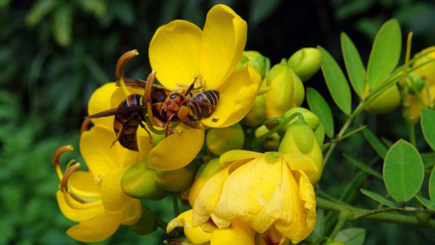Fear of Predators Drives Honey Bees Away from Good Food Sources
October 4, 2013
By Kim McDonald
Most of us think of honey bees as having a bucolic, pastoral existence–flying from flower to flower to collect the nectar they then turn into honey. But while they’re capable of defending themselves with their painful stings, honey bees live in a world filled with danger in which predators seize them from the sky and wait to ambush them on flowers.

The smaller hornet studied by the researchers attacks a honeybee forager on a flower.
Image by Ken Tan
Such fear drives bees to avoid food sources closely associated with predators and, interestingly, makes colonies of bees less risk-tolerant than individual bees, according to a study published in this week’s issue of the open-access journal PLOS ONE.
“This strategy of colonies collectively exhibiting significantly more caution than the riskier individual foragers may help honey bees exploit all of the available food sources, with some intrepid foragers visiting more dangerous food while the colony judiciously decides how to best allocate its foraging,” says James Nieh, a professor of biology at UC San Diego.
Nieh worked with scientists at Yunnan Agricultural University in China to study the impact on foraging Asian honey bees of the monstrous-looking Asian Giant hornet, Vespa tropica, and a smaller hornet species known as Vespa velutina, which has invaded Europe and now poses a threat to European honey bees.
“The Asian Giant hornets are dangerous, heavily armored predators,” says Ken Tan, the first author of the paper, who also works at the Chinese Academy of Science’s Xishuangbanna Tropical Botanical Garden. “Bee colonies respond by forming balls of defending bees, encasing the hornet and, in some cases, cooking it to death with heat generated by the bees.”
The researchers found that bees treated the bigger hornet species, which is four times more massive than the smaller species, as more dangerous. In a series of experiments, they presented bees with different combinations of safe and dangerous feeders–depending on their association with the larger or smaller hornets–containing varying concentrations of sucrose.
“Bees avoided the dangerous feeders and preferred feeders that provided sweeter nectar,” says Nieh. “However, predators are clever and can focus on sweeter food, ones which bees prefer. So we also tested how bees would respond when sweeter food was also more dangerous. What we found was that the individual bees were more risk-tolerant. They avoided the giant hornet at the best food, but continued to visit the lower quality food with the smaller hornet.”
Other scientists involved in the research were Zongwen Hu, Weiwen Chen, Zhengwei Wang and Yuchong Wang, all of the Eastern Bee Research Institute of Yunnan Agricultural University. The PLOS ONE paper is available online here.
Media Contact: Kim McDonald (858) 534-7572, kmcdonald@ucsd.edu
